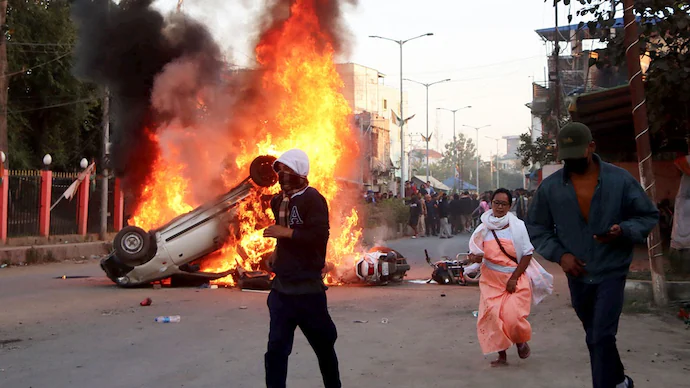– Dr. M. Iqbal Siddiqui
On May 3, 2025, Manipur marked two years since the eruption of a brutal ethnic conflict between the Meitei and Kuki-Zo communities – a crisis that has claimed over 260 lives, displaced more than 60,000 people, and reduced 4,786 homes to ashes. Despite the imposition of President’s Rule in February 2025, violence continues unabated, further entrenching the division of the state into hardened ethnic enclaves. Amid this turmoil, the Meitei Pangal (Muslim) community – marginalised yet largely neutral – remains caught in the crossfire, striving to uphold peace while navigating escalating hardships. In this context, it becomes crucial to revisit the chronology of the crisis, unpack its underlying causes, scrutinise the roles of both the Central and state governments, reflect on the plight of the Pangals, and explore potential pathways to healing Manipur’s fractured social fabric.
A Storied Past
Manipur, nestled in the northeastern frontier of the Indian subcontinent, carries a storied legacy that stretches back to 33 CE, when the Meitei kingdom of Kangla was established – a fact recorded in the Cheitharol Kumbaba (Royal Chronicle of Manipur), among Asia’s oldest royal chronicles. For centuries, the Ningthouja dynasty ruled over a culturally vibrant and politically resilient kingdom, where indigenous Sanamahi traditions harmoniously coexisted with the later influx of Vaishnavism, creating a unique syncretic ethos. Its strategic location along the ancient Silk Route turned Manipur into a thriving centre of trade and cultural exchange with Southeast Asia, particularly Myanmar and China, a legacy still visible in the art of Manipuri polo – regarded as one of the oldest known form of the sport. The people of Manipur displayed remarkable courage during the Anglo-Manipur War of 1891, where figures like Bir Tikendrajit chose martyrdom over submission, resisting British imperial aggression with valour. Although Manipur briefly reclaimed autonomy as a constitutional monarchy in 1947, its controversial merger into the Indian Union in 1949 – after Maharaja Bodhchandra was pressured into signing the Merger Agreement – left deep scars. This forced integration, formalised in 1950, sowed seeds of political alienation and identity-based anxieties that still reverberate in the collective psyche. Over time, these unresolved tensions fed multiple insurgencies and sharpened ethnic fault lines. Despite its political upheavals, Manipur has nurtured an extraordinary cultural legacy – Classical Dance – Manipuri Ras Leela, Martial Art – Thang-Ta and Ancient Text – Cheitharol Kumbaba. Yet today, this mosaic of civilisation stands strained, as historical wounds and layered identities wrestle for recognition, equity, and peace in a land that once stood as a bridge between worlds.
A Diverse Religious Landscape
Let us explore Manipur’s vibrant religious tapestry, which is shaped by indigenous and external influences. As per the 2011 Census, Hinduism and Christianity each claim about 41% of the population, with Meitei Hindus in the Imphal Valley blending Vaishnavism with Sanamahi worship at sites like Shree Govindajee Temple, while Christian tribes – Nagas, Kukis, and Zo – dominate the hills, following Baptist and Catholic traditions introduced by 19th-century missionaries. Sanamahism, practised by a segment of the Meitei community, revives the animist worship of deities like Lainingthou Sanamahi. Islam, followed by 8.4% of Pangal Muslims, descendants of 17th-century traders, thrives in Thoubal and Kakching. Small Buddhist communities, including Tibetan and Ambedkarite followers, add to the diversity. This syncretic and autonomous religious mosaic, while culturally rich, underscores the ethnic divides fueling the crisis.
A Timeline of Turmoil
Manipur’s ethnic tensions predate 2023, rooted in historical land disputes and political imbalances. The Meiteis, comprising 53% of the population, dominate the Imphal valley, while Kuki-Zo and Naga tribes (40%) inhabit the hills. The Meitei Pangals, comprising about 8% of the state’s 3.2 million people, are Muslims within the broader Meitei ethnicity, primarily residing in the valley and buffer zones such as Kwakta.
On May 3, 2023, violence erupted when the Manipur High Court recommended Scheduled Tribe (ST) status for Meiteis, prompting protests by Kuki-Zo and Naga tribes fearing loss of privileges. Arson, killings, and displacement followed, with curfews and internet bans imposed.
By July 2023, a viral video of violence against Kuki women sparked national outrage. Sporadic clashes continued through 2024, fueled by looted armouries and armed militant groups. In September 2024, renewed violence in Jiribam killed 11, including Pangal families caught in buffer zones. Chief Minister N. Biren Singh’s resignation in February 2025 paved the way for President’s Rule under Article 356, yet peace remains elusive. As of May 2025, Manipur stands divided, with federal forces patrolling buffer zones between Meitei and Kuki territories.
Roots of the Crisis
Manipur’s ongoing crisis is rooted in deep ethnic and territorial divisions, especially between the dominant Meiteis and the tribal Kuki-Zo communities. The Meiteis’ push for Scheduled Tribe status – aimed at accessing hill lands and reservation benefits – has sparked fierce opposition from the Kuki-Zo, who view it as a threat to their autonomy. Under Chief Minister N. Biren Singh, a Meitei, eviction drives against Kuki villages – labelled as “encroachments” – and selective enforcement of anti-drug campaigns (notably impacting the Pangal Muslim minority) have exacerbated mistrust. Between 2017 and 2023, Pangals made up over 40% of drug-related arrests despite being a smaller population segment. Kuki settlements were demolished citing forest encroachments, while similar Meitei villages were spared. The 2021 Myanmar coup intensified refugee inflows and arms smuggling, amplifying Meitei anxieties over demographic shifts. Economic neglect and exclusionary laws like the 2018 Protection of Manipur People Bill have further marginalised minority communities.
Government Response: Inaction and Oversight
The state government, led by Singh until his resignation in 2025, faced widespread accusations of partisanship. His inflammatory rhetoric and policies favouring Meiteis alienated Kuki-Zo communities, while curfews, internet bans, and “shoot at sight” orders failed to curb violence. Pangal SP was sidelined, excluded from peace committees despite his mediation efforts. The Central government deployed 40,000 troops, paramilitary forces, and drones, but Union Home Minister Amit Shah’s visits in 2023 and 2024 yielded no ceasefire. Prime Minister’s prolonged silence until July 2023 and absence from Manipur drew criticism. President’s Rule has not bridged ethnic divides, and both governments are faulted for enabling vigilante groups like Arambai Tenggol and ignoring minority voices, including Pangals.
The Meitei Pangal: Neutral but Vulnerable
The Meitei Pangals have played a unique role as peacemakers while enduring significant hardship. Remaining largely neutral, they facilitated essential transport from Guwahati to Imphal and advocated for peace through leaders like Maulana Saeed Ahmed and the United Meitei Pangal Council. Yet, exclusion from platforms like the 2023 peace committee under Governor Uikey undermined their efforts and neutrality. Internally, the community is divided – urban Pangals often align with Meitei parties for security, while rural ones resist pressure to pick sides. A faction seeks ST status, echoing Meitei demands, though others fear alienation.
Rising violence, such as the May 2024 Kwakta attack that paralysed a minor, has radicalised some youth, leading to self-defence groups. At least eight Pangals have died and 13 were injured since 2023. They were compelled to label their homes as “Muslim” in a desperate bid to ward off mob violence. As transporters, they face economic losses from blockades, with hoarding further inflating prices amid growing political neglect.
Current Scenario: A Divided State
As of May 2025, Manipur remains fractured. Violence continues, with Meitei-controlled valleys and Kuki-dominated hills separated by buffer zones patrolled by federal forces. Over 60,000 people, including Pangals, languish in relief camps with inadequate food, water, and sanitation. Yasmin Begum, now displaced, shares a relief camp with 200 others, her trading business having collapsed amidst the violence. Ethnic distrust has deepened, and Pangals’ neutrality is under strain as violence encroaches on buffer zones. President’s Rule has not restored governance, with opposition parties demanding elections. Myanmar’s instability fuels arms and drug smuggling, complicating security and threatening Pangal trade routes.
Pathways to Peace: Resolving the Manipur Crisis
Resolving Manipur’s crisis requires a multi-pronged approach. First, an inclusive peace committee, including Meitei, Kuki-Zo, Naga, and Pangal representatives, must be formed, leveraging Pangals’ neutrality for mediation. A transparent land tribunal should address disputes, ensuring Pangal rights in valley and buffer zones. Economic investments in infrastructure and jobs can stabilise communities, supporting Pangal-led trade networks. Disarming militant groups and recovering looted weapons are critical to reducing threats to neutral groups.
Governance reforms, such as empowering local institutions under Article 371c or the Sixth Schedule, should include Pangal representation. Strengthened border security can curb smuggling from Myanmar, protecting trade routes. Prosecuting perpetrators, including vigilante groups, and investigating attacks on Pangals will restore trust. Inter-ethnic dialogue can rebuild social cohesion, involving Pangal leaders and women’s groups. Targeted aid for displaced Pangals and protection of their economic roles are essential to their recovery.
A Call for Healing and Unity
Manipur’s two-year crisis has left scars on its people, from displaced Kuki-Zo families to Meitei victims and Pangal traders, whose livelihoods are in tatters. The failure of the state and Central governments to address root causes – ethnic divides, economic neglect, and political exclusion – has prolonged the strife. The Meitei Pangals, despite their neutrality and mediation efforts, remain marginalised, their losses a stark reminder of the crisis’s toll. Only through inclusive dialogue, equitable reforms, and a commitment to justice can Manipur heal. The Centre and state authorities must act urgently to bridge divides, protect minorities, and restore peace before the state’s wounds become irreparable.
[The writer is Assistant Secretary, Jamaat-e-Islami Hind]




